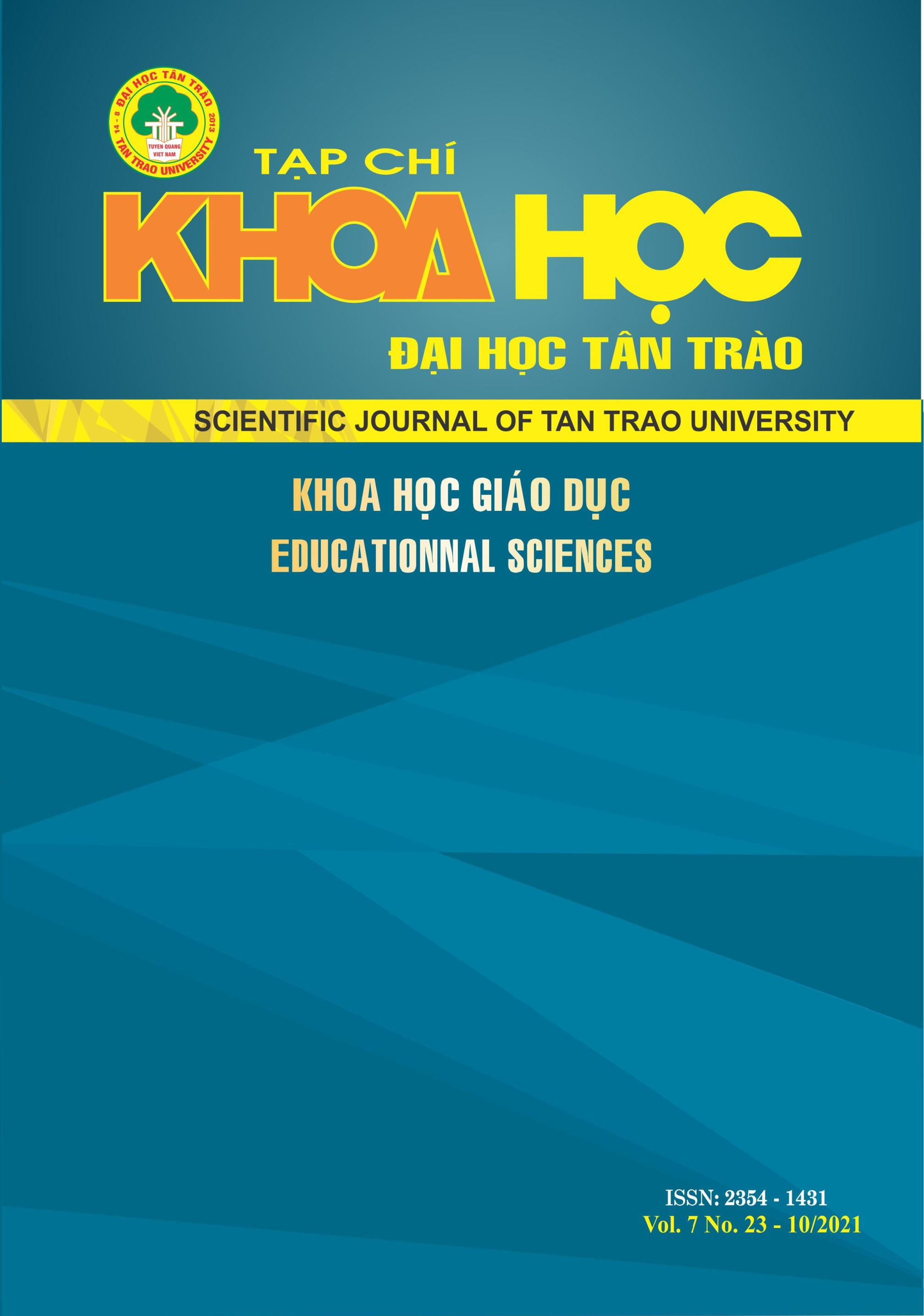HIỆU QUẢ CỦA HOẠT ĐỘNG HỌC TẬP KẾT HỢP Ở BẬC ĐẠI HỌC: NGHIÊN CỨU TẠI TRƯỜNG ĐẠI HỌC GIÁO DỤC – ĐẠI HỌC QUỐC GIA HÀ NỘI
DOI:
https://doi.org/10.51453/2354-1431/2021/558Từ khóa:
dạy há»c kết hợp, giáo dục đại há»c, kết quả đầu raTóm tắt
Trong thời đại công nghệ ngày càng phát triển như hiện nay, dạy học kết hợp (Blended Learning) đang trở thành xu hướng tất yếu, đặc biệt ở bậc giáo dục đại học. Bằng phương pháp nghiên cứu lý thuyết, và điều tra khảo sát sinh viên trên 02 lớp học phần (77 sinh viên) đang triển khai dạy học trong môi trường học tập kết hợp và 01 lớp học truyền thống (33 sinh viên) tại trường đại học Giáo dục – ĐHQGHN, bài báo tập trung chỉ ra các đặc trưng của dạy học kết hợp và đánh giá hiệu quả của hoạt động này về mức độ tham gia, mức độ đạt mục tiêu và kết quả học tập của người học. Kết quả nghiên cứu chỉ ra sự khác biệt có ý nghĩa về sự tham gia và kết quả của người học khi tham gia lớp học truyền thống và kết hợp
Tải xuống
Tài liệu tham khảo
[1] Bleed, R. (2001). A hybrid campus for a new millennium. Educause Review, 36(1): 16–24.
[2] Boud, D., Symes, C. (2000). Learning for real: work-based education in universities. Working knowledge: The new vocationalism and higher education, 14-29.
[3] Quang, B. N. (2013). Impact of consciousness, attitudes, and self-study methods on student academic performance (Case Study of Students in Bilingual Russian-English, University of Social Sciences and Humanities, Vietnam National University, Ho Chi Minh City). Master's Thesis on Measurement and Evaluation in Education. Institute for Education Quality Assurance, Vietnam National University, Hanoi.
[4] Garnham, C., Kaleta, R. (2002). Introduction to hybrid courses. Teaching with technology today, 8(6): 5.
[5] Jessica Bowyer. (2016). Evaluating blended learning: Bringing the elements together.
[6] John Bailey, S. E., Carri Schneider, Tom Vander Ark. (2013). Blended Learning Implementation Guide.
[7] Knight, P., Yorke, M. (2003). Assessment, learning and employability. McGraw-Hill Education (UK).
[8] Khaddage, F., Knezek, G., Rosen, D. (2013). The teacher education evolution: the shift from online to mobile learning in curriculum, assessment and delivery. Society for Information Technology & Teacher Education International Conference.
[9] M. Carman, J. (2005). Blended learning design: Five key ingredients.
[10] McGee, P., Reis, A. (2012). Blended Course Design: A Synthesis of Best Practices (Vol. 16).
[11] Michael B. Horn, Heather Staker. (2014). Blended: Using Disruptive Innovation to Improve Schools (San Francisco: Jossey-Bass).
[12] Norberg, A., Dziuban, C. D., Moskal, P. D. (2011). A time‐based blended learning model. On the Horizon.
[13] Norman Vaughan. (2015). Student assessment in a blended learning environment , INFORMATION AGE PUBLISHING, INC
[14] Pombo, L., Loureiro, M. J., Balula, A., Moreira, A. (2013). Diversity of strategies to promote effective b‐learning: A case study in higher education. Distance and E‐Learning in Transition, 627-644.
[15] Popham, W. J. (2008). Transformative assessment. ASCD
[16] Anh, T. L. (2009). Factors affecting the academic performance of college students. Master's thesis measurement and evaluation in education. The Center for Training Quality Assurance and Educational Development Research, Vietnam National University, Hanoi.
[17] Lan, V. T. N., Hoan, L. T. P. (2018). Self-study activities of first-year students in the Faculty of Electronics and Telecommunications at Saigon University. Journal of Science, 15(4):108-118.
[18] Wang, M.-j. (2010). Online collaboration and offline interaction between students using asynchronous tools in blended learning. Australasian Journal of Educational Technology, 26(6).
Tải xuống
Đã Xuất bản
Cách trích dẫn
Số
Chuyên mục
Giấy phép

Tác phẩm này được cấp phép theo Giấy phép Quốc tế Creative Commons Attribution-ShareAlike 4.0 .
Bài báo được xuất bản ở Tạp chí Khoa học Đại học Tân Trào được cấp phép theo giấy phép Ghi công - Chia sẻ tương tự 4.0 Quốc tế (CC BY-SA). Theo đó, các tác giả khác có thể sao chép, chuyển đổi hay phân phối lại các bài báo này với mục đích hợp pháp trên mọi phương tiện, với điều kiện họ trích dẫn tác giả, Tạp chí Khoa học Đại học Tân Trào và đường link đến bản quyền; nêu rõ các thay đổi đã thực hiện và các nghiên cứu đăng lại được tiến hành theo cùng một bản quyền.
Bản quyền bài báo thuộc về các tác giả, không hạn chế số lượng. Tạp chí Khoa học Tân Trào được cấp giấy phép không độc quyền để xuất bản bài báo với tư cách nhà xuất bản nguồn, kèm theo quyền thương mại để in các bài báo cung cấp cho các thư viện và cá nhân.
Mặc dù các điều khoản của giấy phép CC BY-SA không dành cho các tác giả (với tư cách là người giữ bản quyền của bài báo, họ không bị hạn chế về quyền hạn), khi gửi bài tới Tạp chí Khoa học Đại học Tân Trào, tác giả cần đáp ứng quyền của độc giả, và cần cấp quyền cho bên thứ 3 sử dụng bài báo của họ trong phạm vi của giấy phép.


